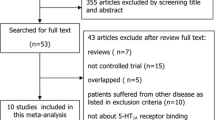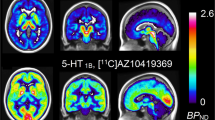Summary
Serotonergic abnormalities have been identified in the brain of suicide victims independent of psychiatric diagnosis. We report the first study of serotonin 5-HT3 receptors in the brain of suicide victims. There were no differences in the number (Bmax) or affinity (K d ) of 5-HT3 receptors in the temporal cortex of suicide victims compared to matched controls. There was a negative correlation between brain serotonin levels and receptor number (r=−0.5, p=0.04) in both groups. This study indicates that alterations in serotonergic function in the brain of suicide victims do not appear to directly involve the 5-HT3 receptor.
Similar content being viewed by others
References
Abi-Dargham A, Laruelle M, Wong DT, Robertson DW, Weinberger DR, Kleinman JE (1993) Pharmacological and regional characterization of [3H]LY278584 binding sites in human brain. J Neurochem 60: 730–737
Apud JA (1993) The 5-HT3 receptor in mammalian brain: a new target for the development of psychotropic drugs. Neuropsychopharmacology 8: 117–130
Arango V, Ernsberger P, Marzuk PM, Chen J-S, Tierney H, Stanley M, Reis DJ, Mann JJ (1990) Autoradiographic demonstration of increased serotonin 5-HT2 and β-adrenergic receptor binding sites in the brain of suicide victims. Arch Gen Psychiatry 47: 1038–1047
Barnes NM, Costall B, Ironside JW, Naylor RJ (1988) Identification of 5-HT3 recognition sites in human brain tissue using [3H]zacopride. J Pharm Pharmacol 40: 668
Costall B (1993) The breadth of action of the 5-HT3 receptor antagonists. Int Clin Psychopharm 8: 3–9
Gorwood P, Ades J, Feingold J (1994) Are genes coding for dopamine receptors implicated in alcoholism. Eur Psychiatry 9: 63–69
Henteleff RA, Arango V, Mann JJ (1992) Serotonin 5-HT2 but not 5-HT1C receptor number is increased in hippocampus of suicide victims [Abstract]. Soc Neurosci Abstr 18: 1598
Korpi ER, Kleinman J, Goodman SI, Phillips I, DeLisi LE, Linnoila M, Wyatt RJ (1986) Serotonin and 5-hydroxyindoleacetic acid in brains of suicide victims. Comparison in chronic schizophrenic patients with suicide as cause of death. Arch Gen Psychiatry 43: 594–600
Lagattuta TF, Henteleff RA, Arango V, et al (1992) Reduction in cortical serotonin transporter site number in suicide victims in the absence of altered levels of serotonin, its precursors or metabolite [Abstract]. Soc Neurosci Abstr 18: 1598
Lowry OH, Rosenbrough NJ, Farr AL, Randall RJ (1951) Protein measurement with the folin phenol reagent. J Biol Chem 193: 265–275
Mann JJ, McBride PA, Brown RP, Linnoila M, Leon AC, DeMeo MD, Nieczkowski TA, Myers JE, Stanley M (1992) Relationship between central and peripheral serotonin indexes in depressed and suicidal psychiatric inpatients. Arch Gen Psychiatry 49(6): 442–446
Mann JJ, Underwood MD, Arango V (1995) Postmortem studies of suicide victims. In: Watson SJ (ed) Biology of schizophrenia and affective disorders. Raven Press, New York
Maricq AV, Peterson AS, Brake AJ, Myers RM, Julius D (1991) Primary structure and functional expression of the 5HT3 receptor, a serotonin-gated ion channel. Science 254: 432–437
McPherson GA (1985) Analysis of radioligand binding experiments: a collection of computer programs for the IBM PC. J Pharmacol Meth 14: 213–228
Munson PJ, Rodbard D (1980) LIGAND: a versatile computerized approach for characterization of ligand-binding systems. Anal Biochem 107: 220–239
Nauta WJH (1961) Fibre degeneration following lesions of the amygdaloid complex in the monkey. J Anat 95: 515–531
Nink M, Salomon E, Coutinho M, Treese N, Bernhard G, Krause U, Beyer J, Lehnert H (1994) Corticotropin-releasing hormone (CRH) is a respiratory stimulant in humans: a comparative study of human and ovine CRH. Life Sci 54: 1793–1799
Pratt GD, Bowery NG, Kilpatrick GJ, Leslie RA, Barnes NM, Naylor RJ, Jones BJ, Nelson DR, Palacios JM, Slater P, et al (1990) Consensus meeting agrees distribution of 5-HT3 receptors in mammalian hindbrain. Trends Pharmacol Sci 11: 135–137
Webster M-T, Francis PT, Procter AW, Stratmann GC, Doshi R, Mann DMA, Bowen DM (1994) Postmortem brains reveal similar but not identical amyloid precursor protein-like immunoreactivity in Alzheimer compared with other dementias. Brain Res 644: 347–351
Whitlock DG, Nauta WJH (1965) Subcortical projections from the temporal neocortex in Macacca mulatta. J Comp Neurol 106: 183–212
Author information
Authors and Affiliations
Rights and permissions
About this article
Cite this article
Mann, J.J., Arango, V., Henteleff, R.A. et al. Serotonin 5-HT3 receptor binding kinetics in the cortex of suicide victims are normal. J. Neural Transmission 103, 165–171 (1996). https://doi.org/10.1007/BF01292625
Received:
Accepted:
Issue Date:
DOI: https://doi.org/10.1007/BF01292625




